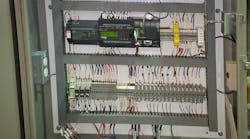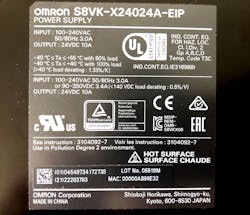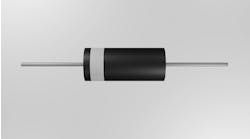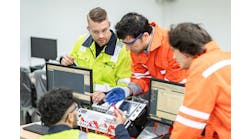A Control Design reader writes: Having spent many years writing PLC programs, I am familiar with electrical and pneumatic schematics and am creating these design documents. However, lately, I'm drawing these schematics and panel layouts myself, and I am constantly thinking about what are the best practices in control panel design. I'm in need of a mentor.
I'm creating many designs for industrial control systems small to large, most with small to midsize PLCs that control machines and equipment. Can you point me to national and international standards that I should be using and other resources to get the design right. I want to ensure I get the wiring, panel layouts and integration done in an industry standard way.
ANSWERS
HMI industry standards
The interactive impact of the human-machine interface (HMI) is much more significant than its basic functionality. An HMI system is the principal point of contact between the user and a machine or process. A good HMI system makes this interaction seem intuitive. A poor HMI system can alienate users or potential customers, encourage users to circumnavigate the system or result in poor or unsafe system performance. As the direct link to the user, the HMI directly represents the core system’s quality and value. A sophisticated mix of design and layout considerations, such as contemporary style, color and tactile response, coupled with ergonomic and intuitive operation, create an optimal user experience that determines a customer’s satisfaction with the core product.
A highly reliable HMI system that delivers safe, cost-effective, consistent and intuitive performance relies on the application of engineering best practices throughout design and panel layout, production, testing and quality assurance processes. Just as critical, in-depth knowledge of and compliance with all relevant ergonomic, safety and industry standards must inform each step of the design and manufacturing cycle. Clear definitions of the functional requirements, the operator’s level of expertise and any communications/interactions with other systems provide the starting point in the knowledge-intensive design process.
The tools needed for effective operator control of the equipment, as well as the requirements of the overall application, determine the selection of interface functions. There are many factors to consider in the initial design phase that are critical to both the HMI and the core system to which it is interfaced. Besides industry and functional requirements, selection priorities also depend upon the experience level of the operator and environment, among many other factors. The driving priority might tilt toward ergonomics, for example, as is the case for applications subject to ADA (Americans With Disabilities Act) guidelines. On the other hand, production floor applications are typically robust and strictly functional, driven by the need to withstand a harsh environment. In the transportation industry, for example, consistency with a previous design—to provide a consistent operator environment—is very often the ruling priority.
A thorough knowledge of technical ergonomic, design and manufacturing standards is fundamental to proper and effective HMI system design whether working independently or with a sanctioned design partner. These include engineering standards, such as MIL-STD-1472F, which establishes human engineering design criteria for military systems, subsystems, equipment and facilities; federal standards set by the Americans With Disabilities Act; and industry guidelines such as those from SEMI S2-93, the global semiconductor industry association, covering HMI for semiconductor manufacturing equipment. Additional HMI specifications are defined by the American National Standards Institute (ANSI), the Institute of Electrical and Electronics Engineers (IEEE), the International Organization for Standardization (ISO) and others.
The EU provides specifications in its EU Machinery Directive for any equipment for domestic, commercial or industrial applications that have parts actuated by a power source other than manual effort. Meeting this directive earns the equipment a CE mark. There are also standards for public access HMI systems, including security and cryptography standards for systems that handle payment cards; specific flammability standards and test procedures for transportation systems; and medical device and equipment standards.
Depending on the ultimate product application, observing appropriate standards ensures that a product will meet industry criteria. This includes the placement of components, legend size and color, emergency stop switch configuration and guards and other ergonomic factors that improve usability, efficiency and safety.
U.S. and industry standards by application
Manufacturing and Process Industries (shop floor applications) International standards
- EU Current Machinery Directive, from Dec. 2009
- MIL-STD-1472F, addresses human engineering design criteria for military systems, subsystems, equipment, and facilities
- IP (International Ingress Protection) codes
- ISO 9001 and ISO 14001
- CE Mark—meets European Union (EU) requirements and guidelines for safety, health, or environmental requirements
- CSA International—Canadian Standards Association provides product testing and certification
- UL, C-UL—Underwriters Laboratories, U.S./Canadian rating organization
- VDE—Electrical, Electronic & Information Technologies, a German testing organization
- DIN EN ISO 13850: 2008 (Safety of machinery—emergency stop—principles of design) The first edition of ISO 13850 (published in 1996) replaced the EN 418 “Emergency Stop” directive in March 2008. Significant changes in this second draft mandate the manual resetting of E-Stops; require E-Stops to use mechanical latching; and state that the revision will remain unchanged until 2010.
U.S. Federal
- ADA Standards for Accessible Design, 28 CFR Part 36
- NEMA (National Electrical Manufacturers Association) similar to the international IP standard, e.g., the NEMA 4 standard is similar to IP 65
- ANSI
Industry standards
- IEC Safety Integrity level (SIL)
Transportation Industry
- ISO: 9000, specifically for railway
- EN 5155 develops standards for electronics on railway passenger vehicles
- The Federal Railroad Administration (FRA, under the U.S. Department of Transportation) is responsible for defining standards covering safety issues
- ASTM (under ANSI) specifies testing procedures in transportation; A range of ASTM standards provide methodology and performance specifications for testing FRA regulations flammability testing
- 49 CFR Appendix B to Part 238 – Test Methods and Performance Criteria for the Flammability and Smoke Emission Characteristics of Materials Used in Passenger Cars and Locomotive Cabs
- ADA
- ANSI
- IEEE
- IRIS (International Railway Industry Standard) Rev. 02; ensures products meet globally recognized quality levels
Semiconductor Industry
- Semiconductor Equipment and Materials International
- Safety Guidelines for Semiconductor Manufacturing Equipment SEMI S2-93
- Safety Guidelines for Ergonomics/Human Factors Engineering of Semiconductor Manufacturing Equipment SEMI S8-95
Medical Industry
- ISO Standards for medical devices—ICS 11.1100.20 and ICS 11.040.01 [5], [6]
- Quality and risk management—ISO 13485 and ISO 14971
- IEC 60601-1 and IEC 62304 for medical software
- U.S. FDA 21 CFR Subchapter H—medical Devices [7]
- Food, Drug, and Cosmetic Act—Section 510(k) —for pre-market notifications
JOHN PANNONE / VP Sales, HMI systems, key customer management, North America / EAO
Art and common sense in design
If you are designing control panels for the North American market, one of the best standards to be familiar with is UL508A. UL508A is a standard for the construction of electrical control panels. Additionally, the National Fire Protection Agency (NFPA) 79A (Electrical Standard for Industrial Machinery) and the National Electrical Code (NFPA 70) are great resources.
Europe has its own standards, mainly IEC (International Electrotechnical Commission). I would start with a study of the various IEC standards. For example, IEC 60204-1 is a basic safety standard, “Electrical equipment of machinery—Part 1: General requirements for the electrical equipment of machines.” There are many IEC standards, and individual countries have their own versions of the IEC standards.
There are two things to keep in mind:
- Always follow the codes for the country/region that the control panel is going to.
- Use good, common sense.
Simply following codes is only part of the art of designing control panels. A neat, nicely laid-out control panel is very important. The Internet has a plethora of resources for you; definitely research articles and look at other designs.
In my opinion, providing a great panel design is a mixture of engineering, art and common sense.
JIM DAVIS / automation engineer / Motion Industries
Component considerations and codes
Control panel design requires knowledge in several interrelated areas.
Codes
- Hazardous area considerations: This may define the type of protection required of the enclosure and/or the components.
- If the panel must be UL approved, the pertinent UL standards must be followed. This may dictate the components that may be allowed.
Electrical considerations
- Follow the applicable codes (the National Fire Protection Agency (NFPA) handbook), and UL standard when required
- Wire size, type and color or insulation
- Fuses, circuit breaker
Thermal considerations
- Consider the temperature rating of the items in the enclosure, the heat output of those items and the ambient conditions where the assembly will be installed.
- Various methods for controlling the internal temperature can be utilized if necessary: selection of the exterior color, insulation, air purging, insulation, heater/thermostat, compressed air cooler, air conditioning.
Familiarity of various components: This comes with experience and involves knowing which types of components are acceptable for the sector you are selling to. Having knowledgeable vendors and distributors can be a big help.
- Enclosure
- Wire ducts or guides
- Wire markers
- Terminal blocks
- Fuses, circuit breakers
Client’s requirements
- Where will it be located?
- How will the client access it?
- Does it need a convenience outlet or internal lighting?
- From which direction(s) will the client run his cabling or conduit?
Practical sense (if not defined elsewhere)
- Space needed between components
- Space between component wiring terminals and wire ducts
- Size of wire duct
- Space to allow between cable entry and ducts or components
- Space around the edge of the panel
- Location of some components relative to others for ease of access, considerations for inter-wiring or other factors.
MICHAEL CORWIN / manager, customer support / Moore Industries International
PLC definitions and requirements
IEC 61131 is an IEC standard for programmable logic controllers (PLCs). The purposes of this standard are:
- to establish the definitions and identify the principal characteristics relevant to the selection and application of PLCs and their associated peripherals
- to specify the minimum requirements for functional, electrical, mechanical, environmental and construction characteristics, service conditions, safety, EMC, user programming and tests applicable to PLCs and the associated peripherals.
IEC 61499 proposes applications hosted and running in several devices.
IEC 61499 proposes applications hosted and running in several devices. Function blocks running in different devices, within a distributed application, have to be strongly coupled, so it is required to have more sophisticated synchronization methods than IEC 61131-3 defines. For example, in contrast with the Send/Receive functions or Networked Variables, the IEC 61499 offers publisher/subscriber and client/server services.
NEMA GFCI P1-2019 covers products intended primarily to protect human beings from the harmful effects of electric shock by sensing ground fault(s) and/or leakage current(s) on grounded and/or ungrounded systems rated 1,000 Vac or Vdc and below.
NEMA IA 2.2-2005 Programmable Controllers (PLC), Part 2 Equipment Requirements and Test specifies requirements and related tests for PLC and their associated peripherals, such as programming and debugging tools and human-machine interfaces, which are intended to be used for the control and command of machines and industrial processes.
NEMA IA 2.3-2005 Programmable Controllers (PLC), Part 3 Programming Languages specifies syntax and semantics of programming languages for PLC as defined in Part 1 of IEC 61131.
NEMA IA 2.5-2005 Programmable Controllers (PLC), Part 5 communications specifies communication aspects of a PLC. This standard is a NEMA Adoptive Standard based on Part 5 of IEC 61131.
The control panel needs to be UL Standard 60947-4-1 or NEC compliant. Article 409 [Industrial Control Panels] of the National Electrical Code (NEC) has been a part of the code since the 2005 edition. Industrial control panels are defined in Article 100. Basically, these panels can be any assembly of relays, pushbuttons and motor controllers.
DANIEL WEISS / senior product manager / Newark
UL508a certified
My answer is relatively simple: get certified for UL508a. There are as many wrong ways to design as there are control panels, and one correct way—designing it to UL508a standards and building it out to those standards, so it can pass certification.
It is very important to understand that there is a big difference between building a control panel using UL508a-certified components and designing and building a UL508a-certified control panel. Just because the pieces are UL508a, that does not mean the final solution is.
For UL training, visit here. You can find Intertek training for UL 508a certification and panel builder program here.
Take the classes, get certified, design and build your control panels.
It's not hard, but it's not simple.
TED WODOSLAWSKY / director of commercial marketing / c3controls
Components that meet global standards
Figuring out which standards are required for industrial control panel design in different areas around the world can be a daunting task, since the standards change constantly in relation to technological innovation and new safety requirements.
Although there is a movement to harmonize some of these standards, there are still many differences that must be addressed. It is possible to cover most requirements by following a few standards like UL508A, NFPA79 and CSA C22.2 No. 286-17 in North America, and the EU Directive in Europe, as well as the international IEC standards such as IEC 60204-1.
When designing a control panel to meet industry standards, it’s a good idea to choose a component supplier that has both a global presence and a large product portfolio. Suppliers with a presence around the world have more knowledge about standards compliance across all markets, while those with large product portfolios are more likely to offer products that are suitable for a wide range of industrial control systems.
The first step in engineering a panel that meets industry standards is to select components that have been tested and that comply with global standards. This significantly reduces engineering time and cost by unifying the panel design for different markets (Figure 1).
Figure 1: Selecting components that have been tested and that comply with global standards significantly reduces engineering time and cost by unifying the panel design for different markets.
Companies are also developing new component technologies to help panel builders more easily comply with control panel standards while improving design efficiency.
Components that feature a slim profile, consistent heights and a means of making wiring more simple and secure provide advantages that help meet spacing requirements, optimize heat dissipation and simplify the panel layout. It’s also important to follow manufacturing instructions when installing components, including those related to mounting, wiring and device protection, to ensure that the panel is built to comply with industry standards.
DAVE LUNDQUIST / automation engineer / Omron Automation Americas
Customer-driven design
Control panel design is driven by your customer. What are the expectations? Where is the machine located? Europe? Canada? United States? What are the safety requirements?
You must understand the environment where the equipment will be located. NFPA 79 guidelines will ensure worker safety and the machine will perform without any electrical hazards.
The UL 508 and UL 508a standard covers control panel devices used for most industrial machines.
Special consideration is necessary for machinery that will be located in an explosive environment or need to be intrinsically safe.
If the machinery will be shipped to Europe, CE mark is necessary. If the machinery is going to Canada, it must be inspected by CSA inspector for electrical safety.
You can always contact a certified control panel builder to work with you to guarantee conformance. Sometimes working with the experts pays in the long run.
WERNER LAMBERGER / technical support engineer / Automation24
5 best practices for wiring
In terms of laying out industrial control panels, wiring plays an absolutely critical role in effective design and construction. Here are five best practices I’d suggest in that area.
1. Separate power and control wiring
To reduce the possibility of electrical noise affecting the control signals, it is best to separate the power and control wiring. Lay out the panel so that the power and control are in separate sections. Group all power fuses, motor starters and variable frequency drives on the same side of the panel as the incoming power (typically the right side, when facing the front of the panel). Then locate all low-voltage control components on the opposite side. Contactors and variable frequency drives will require some control wiring. Consider how you can route the control wires over to the power side while trying to keep them separated.
2. Separate field wiring from internal wiring
Think about how field wiring going to the machine will route into the panel. Will you use conduit, cables or wireway? Will the wiring enter from the bottom, the top or the side? Referring back to our first best practice, consider how best to keep the power and control wiring separated. Lay out terminal strips so that there are separate wire ducts for the internal and field wiring. This simplifies the field wiring and also helps if you have to disconnect the wiring when shipping the machine.
3. Determine the right size wiring duct
Wire duct can consume a lot of space in a panel, especially if you run extra ducts to separate power and control. The proper size duct for each section is one that’s neither under-filled nor over-filled and one that has space for easy access when wiring. It is sometimes helpful to draw a cross-section of the duct profile in CAD and then fill it with circles that represent the wire sizes and quantities. This quick visual can help evaluate the loading for different size ducts. This is especially useful when working with large-diameter wire and cables.
4. Provide adequate space for wire routing
When designing panel layouts in CAD, it’s tempting to reduce the working space around components in order to shrink the overall size of the panel. However, you also need to provide adequate room to get your hands and tools into spaces. After building a panel, go evaluate the space you put around different devices and take some notes. This will help you improve future design. When working with larger wire, be sure to allow enough room to route and bend those wires.
5. Properly ground the panel and devices
Include a row of ground terminals in the panel and connect all ground wires here, including grounds from components, doors and the subplate. Consider mounting a ground terminal adjacent to the disconnect and running a large ground wire between it and the ground terminals. This makes it obvious where to terminate the ground for the incoming power.
Three useful national and international standards:
- NFPA79: Electrical Standard for Industrial Machinery—The official standard description is: “NFPA 79 provides safeguards for industrial machinery to protect operators, equipment, facilities, and work-in-progress from fire and electrical hazards,” but it contains a wealth of helpful information and is an essential tool for anyone designing industrial controls and equipment.
- UL508A: the UL standard for the construction of Industrial Control Panels
- CE specifications for Europe – The CE specifications contain a mix of directives and standards, including 2006/42/EC Machinery Directive, 2014/35/EU Low Voltage Directive, 2014/30/EU Electromagnetic Compatibility Directive and a long list of other standards for machine safety systems, risk assessments, guarding, ergonomics.
There are also separate standards for specific types of equipment. The best way to get started is to consult with a notified body. A notified body is an organization authorized by the EU to assess the conformity of products. They can help you determine which directives and standards are applicable to your equipment and also discuss methods for certifying your equipment.
Some of the Machinery Directive elements should be incorporated into your standard designs. They’re good practice and will help you create a more universal design. For example, use green/yellow wire for grounds and use touch-safe components throughout the panel.
And finally, for panel design and build resources, we have a section of Allied’s Expert Advice content dedicated to industrial control panels, and we’ve partnered with both Schneider Electric and Eaton on industrial panel builder digital resource hubs.
JIM DAVIS / director of advanced solutions and technical support / Allied Electronics & Automation






